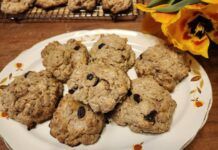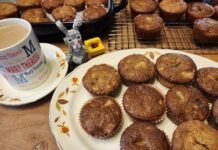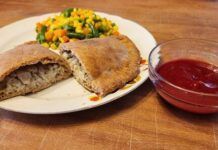
Click here to subscribe today or Login.
Wednesday, September 25, 2002 Page: 1D
For a long time, I had trouble with cheesecakes. They were OK, but they
never turned out really great. Determined to master the form, I practiced and
practiced, trying different recipes and reading everything I could find about
cheesecakes.
Now, after a solid two years of trial and error, I think I can offer you a
basic cheesecake recipe that’s a winner. It requires few ingredients. And it
is quickly put together, and if you follow my advice step by step, you will
turn out a great cheesecake every time.
But before the recipe, let me define my idea of the perfect cheesecake. Its
texture should be creamy but solid, not loose in the center. It should have a
sweet taste without being cloy. After all, a cheesecake is made from cheese.
The crust should provide a substantial base for the cake but it should also
have a flavor of its own in addition to a crisp character.
The following recipe provides ingredients and proportions. In addition, let
me provide you with the method and a few hints to help you avoid the pitfalls
that stumped me.
First of all, the ingredients, including the cream cheese, should be at
room temperature. I frequently plan ahead and remove the cream cheese from the
refrigerator at night before so it will be soft throughout. That’s if I’m
planning to bake a cheesecake the next day. If your kitchen is cool, microwave
the cream cheese for 10 to 20 seconds to soften it. The brand of cream cheese
does not make a difference in the quality of the finished product. Therefore,
watch for sales and buy the store-brand cream cheese. Do not freeze the cream
cheese, because it will have a grainy texture when defrosted.
Second, be careful about beating the cream cheese. Do so until it develops
a thick, rich and smooth consistency. It is important to scrape down the sides
of the mixing bowl frequently while you smooth the cheese, even if the total
time you are mixing is only one minute. There should never be any lumps in the
batter.
Third, do not whip the ingredients longer than necessary. In one experiment
to lighten a cheesecake, I thought really whipping the batter would work. I
initially blended the cheese and sugar for about 10 minutes and then beat the
batter for another 10 minutes after adding the eggs. What I created was
something akin to a souffle, which rose right out of the pan and onto the oven
floor resulting in a large mess in the pan – and in the oven.
Fourth, baking a cheesecake in a water bath has never worked for me. Even
if I surrounded the pan with aluminum foil or plastic wrap or both, I always
ended up with a soggy cheesecake. Now I put a very large pan or two smaller
pans of water in the bottom of the oven. This creates a sauna in which the
cake can bake.
Fifth, to prevent the cheesecake from cracking in the center, I bake the
cake at a low temperature – 200 to 250 degrees – for quite a long time – 1-1/2
to 2 hours. If I bake a cheesecake at any higher temperature, I always get a
raised and browned dry-tasting outer edge.
Don’t check the cheesecake’s progress in the oven until one hour has
passed. Remember, you want to maintain a sauna inside the oven and frequently
opening the door will allow humidity to escape.
There are other things to prevent a cheesecake from cracking. For example,
running a knife around the cake as soon as it comes out of the oven and
allowing the cake to come to room temperature slowly before chilling it.
Usually these tips work for me, but every so often I get a cracked
cheesecake. I have learned that this is not the end of the world. A cheesecake
is quite malleable until it is thoroughly cooled. So using my fingers, I just
press the edges of any cracks together. You can then cover the cake with a
fruit topping or a sour cream layer to hide an unsightly top.
There are many variations to the theme. The most simple is substituting
another flavor for the vanilla. Eliminate it and add almond extract or any
liqueur such as amaretto or Grand Marnier. At the end of the recipe, I’ve
suggested a few others. The more you make this cheesecake, the more delicious
variations you will think of.
CHEESECAKE MASTER RECIPE
Shell:
1 1/2 cups crushed vanilla wafers
1/2 cup finely chopped nuts – walnuts, almonds, pecans, or hazelnuts
1 tablespoon sugar
6 tablespoons melted butter
Coat the inside of a 9- or 10-inch springform pan with cooking spray. Mix
all ingredients together in the pan and press to cover the bottom of the pan.
Bake at 350 degrees for 10 to 15 minutes or until fragrant and lightly
browned. Remove the base from the oven and reduce the heat to 225 degrees.
Filling:
2 1/2 pounds cream cheese at room temperature
1 1/3 cups granulated sugar
Dash salt
1 teaspoon vanilla extract
4 eggs
1 tablespoon fresh lemon juice
Beat the cream cheese and sugar for 2 minutes. Several times scrape down
sides of bowl, add the salt and extract, and mix for another 2 minutes. Scrape
down the sides of the bowl and make sure the batter is completely smooth with
no large lumps of cheese left.
Add the eggs and lemon juice and beat for one minute. Scrape down the sides
and beat for another 30 seconds or until totally smooth. Do not overbeat.
Place a large pan of water on the bottom shelf or on the bottom of the oven
itself. Pour batter into prepared base and bake at 225 to 250 degrees for
1-1/2 to 2 hours until set. The center will jiggle slightly but feel solid to
the touch. Run a knife around the end of the pan. Then turn off the oven and
let the cheesecake come to room temperature inside the oven with the door
closed.
Optional topping:
3/4 cup sour cream
1/2 cup sugar
1 tablespoon lemon juice
Combine all the ingredients in a bowl and whisk until smooth. Pour onto the
center of the cheesecake as soon as it is done baking. Then return the
cheesecake to the oven, turn off the oven and let the cheesecake come to room
temperature.
Cheesecake variations:
1. Raspberry or cranberry swirl. Place half of the batter into the pan and
add 1/2 cup of prepared raspberry or cranberry sauce over it. Then add the
remaining batter and use a knife through the batter to form swirls of color.
Bake as above. If making a cranberry swirl, add 1/4 cup of real maple syrup to
batter and cut the amount of sugar for the batter to 1 cup instead of the 1
1/3 cups mentioned above.
2. Pina colada. Reduce sugar to 1 cup, add 1/2 cup of bottled pina colada
mix and eliminate the vanilla. Bake as above and top with a pineapple glaze.
To make the topping, put 10 ounces of canned crushed pineapple in food
processor and process on and off several times.
Put pineapple in a pot with 1/2 cup of sugar and 1 tablespoon of lemon
juice. Cook over medium heat and stir. Combine 1 tablespoon of cornstarch with
1 tablespoon of water and add to the pot. Continue to cook until mixture comes
to a boil and thickens. Remove from heat, cool and add to the top of the
cheesecake.
3. Baileys Irish Cream. Add 1/4 cup of Baileys to the batter and eliminate
the vanilla. Add 12 ounces of mini chocolate chips. Bake as above.
4. Citrus. Add another tablespoon of lemon juice or orange or lime juice to
the batter in addition to the grated peel of 2 lemons, limes or oranges or a
combination.
Food Columnist Pat Greenfield’s column is published every other Wednesday.
She is owner and/or operator of restaurants in Exeter, Kingston and Plains
Township. Write to her in care of the Arts & Leisure Team, Times Leader, 15 N.
Main St., Wilkes-Barre, PA 18711-0250.







